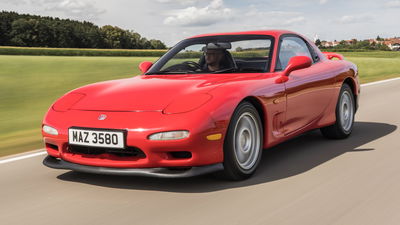Should you press the button when pulling the handbrake or not?
The argument of the button-pressers is that you will wear the teeth of the ratchet down by not pressing the button. Sounds possible, which is why so many people believe it. Which is a pity because it’s wrong. You should not press the button when pulling the handbrake.
The argument of the button-pressers is that you will wear the teeth of the ratchet down by not pressing the button. Sounds possible, which is why so many people believe it. Which is a pity because it’s wrong. You should not press the button when pulling the handbrake.
To understand this we’ll take a look at how the thing works.

The handbrake pivots around a pin and pulls on a cable which is connected to the brake calipers. To lock the handbrake in place when pulled up there’s a ratchet mechanism consisting of a bracket with teeth and a pawl. This pawl is connected via a push rod to the release button. Behind the release button there’s a spring. To make the pawl lock between the teeth of the ratchet bracket it has to be pushed against this bracket. This is done by the spring behind the button. This spring forces the button outwars, pulling on the rod which in turn makes the pawl pivot around a pin, forcing it between the teeth of the ratchet bracket.

In the picture above you see the ratchet bracket. It’s a picture I found on Google of a handbrake mechanism from an old Merc. As you can see the teeth are a little worn. But this shouldn’t be a problem, because the pawl locks between the teeth and not on the top of the teeth. As long as the majority of the tooth is still there the mechanism will lock, provided there’s enough force forcing the pawl into the teeth. And this is where the problem lies.

The return spring behind the release button is the real culprit. When handbrakes don’t lock anymore people immediately think of the ratchet. But in most cases it’s this spring that’s causing the problems.
When a changing force acts on metal you get fatigue. The metal litteraly gets tired and will deform pretty easily. A spring is based on metal’s resistance to deforming. But when the metal is fatigued there’s less resistance to deforming and the spring will lose some, of it’s compression. If this happens less force is forcing the pawl between the teeth of the ratchet bracket and the mechanism will start failing to lock. It will start to happen occasionaly but after a few months it will happen most of the time.
So now back to our original argument. What’s best, pushing or not pushing the button when you pull the handbrake? If we don’t want our mechanism to wear out we want to put as little force on the spring as possible, because big changes in force is what makes the spring wear out. From this we can conclude that you SHOULDN’T push the button when pulling the handbrake. You should let the ratchet mechanism do it’s work and use the button only when necessary (= to release the handbrake).
Think of it. If you push the button everytime you pull the handbrake you will cut the life of the return spring in half. It’ll take half as much time to wear the spring out than it would normally.
This content was originally posted by a Car Throttle user on our Community platform and was not commissioned or created by the CT editorial team.













Comments
Don’t know why people suffer with the ratchet noise. I love it. It’s comforting, it makes me feel safe and hold by my almighty handbrake.
I’m not sure about pressing it or not it’s a bad idea, but i’ll say this: My 1975 Renault 4S had the rathet like new, and the spring like new, and that handbrake was pulled A LOT more than ANY new car. It isn’t an expensive or luxury car, it’s an eco, cheap car,:small engine and just a few horses. So I’m guessing that those two things can hold on on a 75 cheap renault, they will hold on on ANY car.
Jus get a hydro
Only use it like a hydraulic handbrake to do mad drifts
This article is just not correct, the spring’s elastic limit is much higher than you can reach by pressing the button.
But more to the point: the paw is the component that wears, the teeth engage along the full depth of the teeth, not just the root. As the profile of the teeth is reduced (though wear), the strain increases in the teeth.
I’m not talking about plastic deformation, I’m talking about fatigue. Which is caused by changing loads within the elastic limit.
i got rid og the rachet, cuz drift Wagon :P
I had to replace the spring on my Toledo because it was pulled 5times a day for 16 years soooo yeah was about 1.5€ :D
I allways feel that i have forgot to use the handbrake when i press it and walk away from my car :/
tick, tick, tick. 3 ticks + 1st Gear for normal Park.
5 to 6 ticks + 1st Gear for down-, uphill Park, wheels heading to the curb of course.
How the f*ck could you tell how hard you pull your hand brake without the ticking sound aka not pressing the button?
Question is, what’s cheaper, the spring or ratchet mechanism!
Relatively the ratchet bracket because it needs less treatment to make it. but it’s irrelevant because in most cases the handbrake lever is one unit so if something brakes you have to replace all of it.
Just cause of alex’ face
Pagination